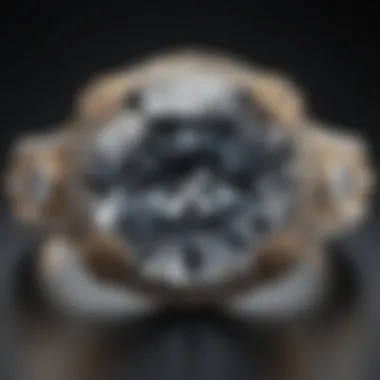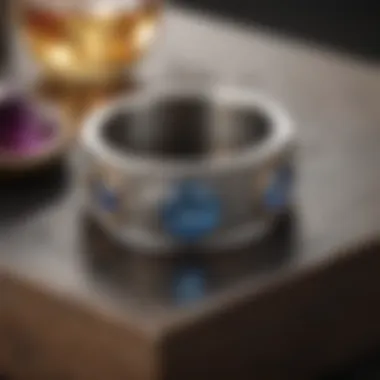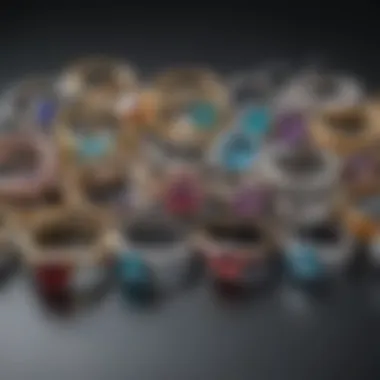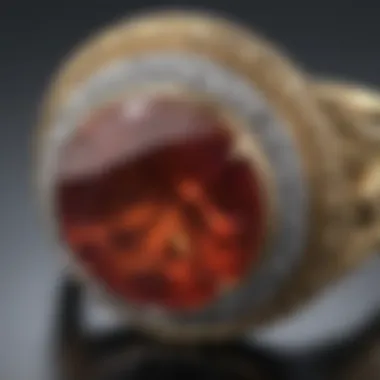Factors Affecting Ring Resizing Timeframes


Intro
When it comes to the art of jewelry, few processes evoke as much intrigue as ring resizing. A ring, often a symbol of love or commitment, is not just a mere piece of metal—it's a narrative that holds personal sentiment. However, the reasons behind resizing vary widely. Whether it’s due to fluctuating body weight, changes in style, or simply a poor initial fit, understanding the timeframe for resizing becomes crucial for both jewelers and customers. This article delves into the multifaceted nature of ring resizing, unpacking the nuances that determine how long the process will take.
Gemstone Overview
Definition and Characteristics
Gemstones are more than ornamental stones; they are exquisite creations of nature. Each stone comes with its own unique characteristics, including color, clarity, carat weight, and cut. These attributes not only contribute to the stone's beauty but also influence how a ring can be resized. For instance, certain delicate stones like opals or pearls may require additional care during resizing due to their softness.
Classification of Gemstones
Gemstones can be classified into various categories: precious and semi-precious. Precious stones, such as diamonds, rubies, and sapphires, are not only valued for their rarity but also for the durability they provide, which can affect the resizing timeline. Semi-precious stones, on the other hand, include a broader range of materials like amethyst and garnet. The resizing of rings embedded with more intricate stone settings often requires specialized labor, thus impacting the overall length of the process.
Historical Significance
Ancient Uses and Cultural Importance
Historically, gemstones have played an essential role in various cultures. They were often thought to hold magical properties or serve as talismans. In ancient times, resizing a ring wasn’t just about fit—there was a cultural context to consider. In many societies, the resizing of a ring was a significant ritual, marking life changes such as marriage or coming of age. Understanding this background can highlight why the resizing of rings still bears such weight today.
Myths and Legends Surrounding Gemstones
Throughout history, gemstones have inspired countless myths. Take the diamond, for example; often regarded as a symbol of invincibility due to ancient beliefs that it could protect the wearer in battle. Myths surrounding other stones, like the sapphire, often involve stories of wisdom or divine favor. These narratives can increase the emotional weight of resizing a ring, emphasizing the importance of carefully handling such pieces.
"The value of a ring is not solely in its material worth, but in the emotions and stories it carries."
Understanding the factors impacting the duration of a resizing process helps both consumers and jewelers navigate expectations. Each stone and design can bring its own set of challenges, affecting how long the project takes from start to finish. In the following sections, we will explore the specific elements influencing resizing timelines, ensuring that you’re well-informed as you embark on this journey.
Foreword to Ring Resizing
When one thinks about rings, especially those that carry emotional weight such as wedding bands or family heirlooms, resizing them might not immediately come to mind. However, the necessity and relevance of this topic cannot be overstated. Ring resizing is an essential service that ensures wearers can enjoy their rings comfortably and with confidence. A ring that fits just right is not only a matter of aesthetics but also personal comfort. This section will shed light on the complexities involved in resizing and why it’s crucial for both the wearer and the jeweler.
Definition and Importance
Ring resizing refers to the process of adjusting the size of a ring to better fit the wearer’s finger. This task might seem straightforward, yet it encompasses a range of skills and considerations that vary depending on the ring's design and materials. The importance of understanding ring resizing goes beyond simply changing the size. It reflects the need for a skilled jeweler who can also maintain the integrity of the design and gemstones involved.
In the world of jewelry, a well-fitted ring not only showcases craftsmanship but also enhances the overall experience of wearing it. A snugly fitting band prevents loss, scratches, or damage to the setting. Many people are unaware that wearing an overly loose ring can lead to unintentional removal, especially during daily activities. Conversely, a ring that is too tight can cause discomfort and even be painful over extended wear. Therefore, knowing when to resize a ring and understanding the resizing process itself is key to preserving both its beauty and safety.
Common Reasons for Resizing
Resizing a ring isn't just triggered by a change in finger size; various circumstances may prompt this consideration. Here are some common reasons why individuals find themselves navigating the resizing journey:
- Changes in Weight: A significant fluctuation in weight can affect finger size, leading to the necessity of resizing.
- Weather Effects: People may notice their rings feel tighter in hot weather due to swelling, while they may feel loose in colder conditions.
- Lifestyle Changes: Engagements, weddings, and other life events can also mark the need for resizing, especially if a new ring is acquired.
- Heirloom Alterations: Family heirloom rings often need resizing for modern wearers who might not have the same finger size as their ancestors.
All these factors culminate in a clear understanding that resizing is not merely a cosmetic change but an essential part of jewelry maintenance. Whether for comfort, utility, or aesthetic, the motivations behind ring resizing are compelling and warrant careful consideration. In the following sections, we will delve deeper into what influences the duration of resizing and how to navigate the resizing process effectively.
Factors Influencing Resizing Duration
When it comes to resizing rings, there’s a whole lot more than just pulling and pushing metal. The time it takes to get that precious band fitted just right can vary significantly based on several factors. Understanding these elements not only helps jewelers manage their workflow but also empowers consumers to set realistic expectations. Key factors include the type of ring material, its design, and much more.


Ring Material
The material that your ring is crafted from plays a pivotal role in how long resizing takes. Each material has its properties, which can either facilitate or complicate the resizing process.
Gold
Gold is treasured for its allure and malleability, making it one of the most popular choices for ring construction. Its key characteristic is its ductility, which allows jewelers to easily manipulate its shape without causing damage. This means that if you need to resize a gold ring, the time involved can be relatively short—often just a few days. However, the softness of gold might also be a disadvantage; repeated resizing can weaken its structure over time.
Silver
When we talk about silver, we're usually referring to sterling silver, which consists of 92.5% silver. One notable aspect is that it’s less expensive than gold, appealing to those on a budget. While resizing a silver ring is possible, it may take longer compared to gold because of its higher propensity to tarnish. Moreover, jewelers must take care to remove oxidized areas during the resizing process, lengthening the timeline slightly.
Platinum
Platinum is a heavyweight in the realm of precious metals, and its density is what sets it apart. Although it can be a bit challenging for jewelers to work with due to its robustness, this metal does excel in holding its form well. For resizing, it can take longer than gold but offers the benefit of durability. Couples who commit to a platinum ring enjoy a piece that may withstand wear better than others, although resizing can be a more time-consuming process due to its high melting point.
Titanium
Titanium holds a unique position as a lightweight and extremely strong metal. It’s corrosion-resistant and offers a modern aesthetic. However, the hardness that makes titanium so appealing also complicates resizing. When working with titanium rings, jewelers often require specialized equipment, which can add to the length of time needed for resizing. It’s known for being a little more tricky to resize than softer metals, such as gold or silver.
Ring Style
The style of the ring also influences the duration of resizing. Different designs present various challenges for jewelers, directly impacting the time frame.
Simple Bands
Simple bands, characterized by their unembellished forms, are the easiest to resize. Their clean lines and minimalistic style mean that jewelers can often handle resizing quickly—sometimes in just a few hours. The lack of intricate settings or gemstones allows for a straightforward process.
Engagement Rings
Engagement rings come with a whole new set of complexities due to their elaborate designs and the presence of gemstones. Resizing an engagement ring is often more time-consuming owing to the care needed to protect the stone during the process. These rings usually take longer, often requiring a week or more, to ensure everything fits seamlessly without compromising the integrity of the piece.
Vintage Styles
Vintage-style rings often incorporate unique artistic elements and settings that can complicate resizing. Their intricate nature may require meticulous adjustments, possibly extending the resizing timeline. Jewelers must work cautiously to maintain the ring's vintage charm while ensuring a perfect fit, and this careful handling can take longer than resizing more contemporary styles.
Complexity of the Design
The complexity of a ring's design also heavily influences the time required for resizing. Rings with intricate details or custom elements can substantially increase the duration of the work. Jewelers often have to employ precision tools and techniques to ensure that the resizing doesn't damage any features of the ring. The more complex the design, the longer the duration is likely to be, highlighting the importance of understanding the specific attributes of your ring when considering resizing.
Typical Timeframes for Resizing
When it comes to ring resizing, the duration of the process can vary widely, and comprehending typical timeframes is essential for both jewelers and those seeking to alter their jewelry. Knowing the expected time can aid in planning, especially if the resizing coincides with a significant occasion. Additionally, it sets realistic expectations none must be left wondering when they can finally slip the ring back onto their finger.
Beyond mere convenience, understanding resizing timeframes can reflect the quality of service offered by a jeweler. A well-established jeweler typically has a more streamlined process, potentially resulting in quicker turnaround times. Moreover, checking these timeframes can also help customers gauge the workload and priorities of the jewelry studio, ensuring they choose a reliable partner for resizing needs.
Standard Resizing Times
The standard time it takes to resize a ring often ranges between a few days to a couple of weeks. Strikingly, this span is often dictated by the complexity of the ring style and the materials involved. A basic band made of gold or silver can usually be resized within a short time frame, often just a few days.


However, here’s where things can differ:
- Simple Bands: 3 to 5 days
- Engagement Rings: 1 to 2 weeks
- Vintage Styles: 2 to 3 weeks, depending on the craftsmanship.
It’s not just about the physical labor; factors like the jeweler’s workload, supply chain delays, and even the time allocated for quality checks play into these durations.
Expedited Services
For those who find themselves in a crunch, some jewelers offer expedited services that can ring in the changes faster than a traditional resizing might allow. These might be ideal during busy seasons like Valentine’s Day or wedding seasons, where time is of the essence.
Many shops offer:
- Same-day Resizing: This is particularly rare and often applies only to simple rings without intricate designs.
- Next-day Services: Ideal for almost all standard styles, provided the jeweler can accommodate the request.
A word of caution: opting for expedited services might come with higher costs. When speed becomes a priority, it’s wise to discuss thoroughly with your jeweler to understand any potential impacts on the quality or the longevity of the resizing process. Remember that good craftsmanship often takes time.
"You can't rush quality, and not everything that glitters is gold; sometimes, you've got to wait a little longer for the sparkle you truly want."
Consultation Process
The consultation process is a crucial first step in understanding the timeline for ring resizing. It serves as the foundation for the entire resizing journey. During this phase, both the customer and the jeweler engage in a dialogue that lays out expectations, identifies specific needs, and addresses any concerns related to the resizing of a ring. This isn’t just a routine chat; it’s about ensuring a smooth experience and achieving the desired outcome.
In the context of resizing, effective communication during the consultation allows for a tailored approach. Each ring holds unique sentimental, aesthetic, and financial value — a one-size-fits-all strategy simply won't fit the bill. Jewelers can better grasp the condition and particularities of a ring if they receive clear details from customers. This might involve discussing what materials are involved, the ring's current design, and its history.
Benefits of a Thorough Consultation
- Identification of Issues: The jeweler can spot any potential issues early on, which can affect the resizing process, such as structural weaknesses or intricate designs.
- Time Management: By understanding the intricacies involved upfront, jewelers can provide a more accurate timeframe, ensuring there are no unwelcome surprises in the duration of the process.
- Personalized Solutions: Each consultation can lead to bespoke solutions based on the individual needs of the client, making the resizing a truly personal experience.
Ultimately, the consultation process is about aligning expectations. Clarity fosters trust between jewelers and customers, and this trust doesn’t just expedite resizing; it also enhances the overall satisfaction with the final product.
Initial Assessment
When customers bring their rings in for resizing, the initial assessment comes into play. This stage is where the jeweler evaluates the ring’s current size and fit before diving into any resizing work. It’s more than just a quick glance; a detailed inspection is essential.
During the initial assessment, jewelers look at various factors relevant to the resizing process:
- Material Composition: Different materials can behave contrastingly when resized. For example, gold can be stretched or cut down easier than platinum, which requires more specialized tools and techniques.
- Current Size and Shape: Jewelers will measure the existing size and observe how well it fits. For instance, if a size adjustment is needed, they’ll make note of how much the size should change.
- Design Elements: Rings with intricate designs or those featuring stones might pose unique challenges during resizing, which can impact the time required.
This thorough evaluation not only informs the resizing strategy but also prepares the customer for what to expect down the line.
Determining Size and Fit
Determining the right size and fit is often a balancing act. It takes into account personal comfort and aesthetic desires. A well-fitted ring feels good on the finger and complements the wearer’s style. Here’s how jewelers typically go about ensuring a perfect fit:
- Sizing Charts and Gauges: Jewelers often use standardized sizing charts to determine the appropriate size. They might also employ ring sizers for more accurate measurements.
- Consulting Personal Preference: The jeweler will usually ask questions about personal preference. For example, should the fit be snug or leave some room for seasonal changes in finger size?
- Considering Future Adjustments: Jewelers sometimes recommend keeping in mind potential future resizing needs, especially for rings worn on a daily basis. If someone plans to fluctuate in weight or climate changes, it’s worth thinking about how those factors might affect ring size.
- Measuring More Than Once: Given that fingers can differ slightly in size, especially the left and right hands, jewelers should ideally measure multiple times to ensure consistency.
"A ring should not only fit snugly but also feel comfortable, allowing for ease of movement without pinching or slipping off."
By taking a careful approach to size determination, jewelers help customers achieve a balance between functionality and aesthetics, setting the stage for a satisfactory resizing experience.


Communication with Jewelers
Effective communication with jewelers can vastly improve the experience of ring resizing. It sets the stage for understanding the process, managing expectations, and ultimately ensuring customer satisfaction. In an industry where details matter more than anything else, knowing how to articulate your needs and concerns is vital.
It’s not simply about dropping off a ring and picking it up later. Clear interaction allows for peace of mind. When you converse with the jeweler, you’re building a relationship of trust. This is especially significant for those whose rings carry sentimental value. You don’t want just any resizing; you want it done right. When you engage in thorough dialogue, you not only express your requirements but also absorb their expertise, enriching your understanding of the resizing procedure.
Questions to Ask
When you're faced with the task of resizing a ring, the right questions can make all the difference. Here’s a shortlist of crucial inquiries to bring up during your consultation:
- What is the estimated time for resizing?
Knowing the timeline helps you plan ahead, especially if you need the ring for a specific occasion. - What is the resizing process for my specific ring type?
Different styles may require different approaches. It’s wise to acquire insight into how your particular ring will be handled. - What are the limitations concerning my ring?
Some rings can only be resized to a certain extent. It helps to know where your ring stands. - Do you have insurance or guarantees for the resizing?
Understanding any added protective measures will help assure you in case of mishaps. - Are there options for expedited services?
If time is of the essence, knowing if there's a rush service is vital.
These questions not only clarify your own situation, but they also reflect your seriousness about the resizing project. Jewelers appreciate clients who are informed and engaged.
Understanding Resizing Limitations
The limitations of resizing a ring can be just as important, if not more so, than the process itself. Not all rings are created equal, and understanding what your jeweler can or cannot do will save you time and possible frustration later.
For example, rings that contain intricate designs, delicate settings, or an assortment of gemstones might be less amenable to resizing than simpler designs. The key aspects to consider include:
- Material Strength: Some metals, like titanium, can present unique challenges when resizing.
- Design Integrity: If a ring features intricate detailing, resizing may distort its aesthetics, making the design unrecognizable.
- Gemstone Stability: For rings adorned with stones, it's crucial to ensure that the gems won’t shift or get damaged in the resizing process.
Being aware of these limitations can help prevent disappointment post-resizing. When you engage effectively with jewelers, you create an avenue to delineate these boundaries and align expectations realistically.
Takeaway: Effective communication paves the way for an successful resizing experience.
Post-Resizing Care
Understanding the right steps to take after resizing your ring can mean the difference between a short-lived fit and a lasting one. Post-resizing care encompasses the actions one should take to maintain not just the physical size of the ring, but its overall condition and beauty. Jewelry is not just an accessory; it often holds emotional significance and financial value. Thus, taking care of it post-resizing is crucial.
Maintaining Ring Condition
Once your ring has been resized, it’s of utmost importance to keep it in prime condition. Here are several tips to boost its longevity:
- Regular Cleaning: Just like you wouldn’t neglect cleaning your car, your ring requires a little TLC too. Utilize a gentle soap and water solution and an old toothbrush; this can help scrub away dirt without scratching the surface. Avoid harsh chemicals or abrasive materials.
- Avoiding Hard Impact: Rings can be delicate, and with the resizing process, even slightly reshaped rings may be prone to deformation. Try to minimize exposure to rough activities. A little common sense can go a long way in maintaining integrity.
- Safe Storage: When your ring isn’t on display, store it in a soft pouch or a designated jewelry box. This protects it from scratches and other unintentional damages. Keeping it in individual compartments is also ideal if you have multiple pieces.
- Professional Inspections: Every once in a while, take your ring to a jeweler for a professional inspection. They can spot any issues before they escalate, ensuring you stay ahead of any potential problems.
Each step might sound simple, but they contribute significantly to your ring’s lifespan. Taking these precautions means you can enjoy your resized ring without second thoughts.
Periodic Size Checks
Even after resizing, it’s wise to keep a little check on the fit of your ring. Factors such as weight fluctuations, temperature changes, and natural wear can affect how a ring sits on your finger. Here’s a quick rundown of why periodic size checks can be beneficial:
- Finger Swelling: Some people notice their fingers swell up in heat or after exercise. A ring that fits just right on a chilly day may feel tight during summer outings. It’s smart to feel it out every now and then.
- Weight Changes: Gaining or losing weight can naturally affect the size of your fingers. Regularly checking your ring for fit keeps you mindful of how your body changes, which can also prompt a proactive resizing.
- Preventive Measure: Frequent size checks can alert you to minor issues before they become problematic. If your ring feels overly tight, it’s easier to address immediately than later when you might have to deal with discomfort or even a stuck ring.
- Comfort: Ultimately, the goal is to ensure comfort. If you notice any discomfort at all, a quick visit to your jeweler can remedy it before you’ve twisted an ankle trying to get it off.
The End
Ring resizing is not just a simple task; it's a process that entails thoughtful consideration of various factors like materials, styles, and individual preferences. This article has shed light on these complexities, highlighting the significance of understanding the timeframe involved in resizing rings. By grasping the intricacies—such as how the type of metal or the design complexity can influence the duration—you can manage your expectations effectively.
Recap of Key Points
- Importance of Material: Different metals like gold, platinum, or titanium each come with distinct properties that affect resizing times. For example, platinum may require more specialized tools and techniques than gold.
- Style Consideration: The type of ring, whether it's a simple band or a vintage piece, plays a crucial role. Intricate designs often take longer due to their complexity.
- Standard vs. Expedited Services: Knowing the general timeframe helps, but opting for expedited services can significantly shorten waiting periods, though at an added cost.
- Communication is Key: Clear dialogue with jewelers about your needs and expectations ensures that the resizing process goes as smoothly as possible.
Final Thoughts on Resizing
Considering the potential emotional and monetary investments in rings, paying attention to resizing details is vital. A well-fitted ring not only enhances comfort but also maintains the piece's aesthetic appeal. Always remember, it’s more than just changing the size; resizing preserves the symbol of your love or commitment. Never hesitate to consult with professionals about what options best suit your situation.
In a world where quick solutions often come at the cost of quality, being informed about the resizing process empowers you to make choices that uphold both the integrity and beauty of your jewelry. Awareness leads to satisfaction, and ultimately every change, whether big or small, deserves the care that goes into perfecting it.







